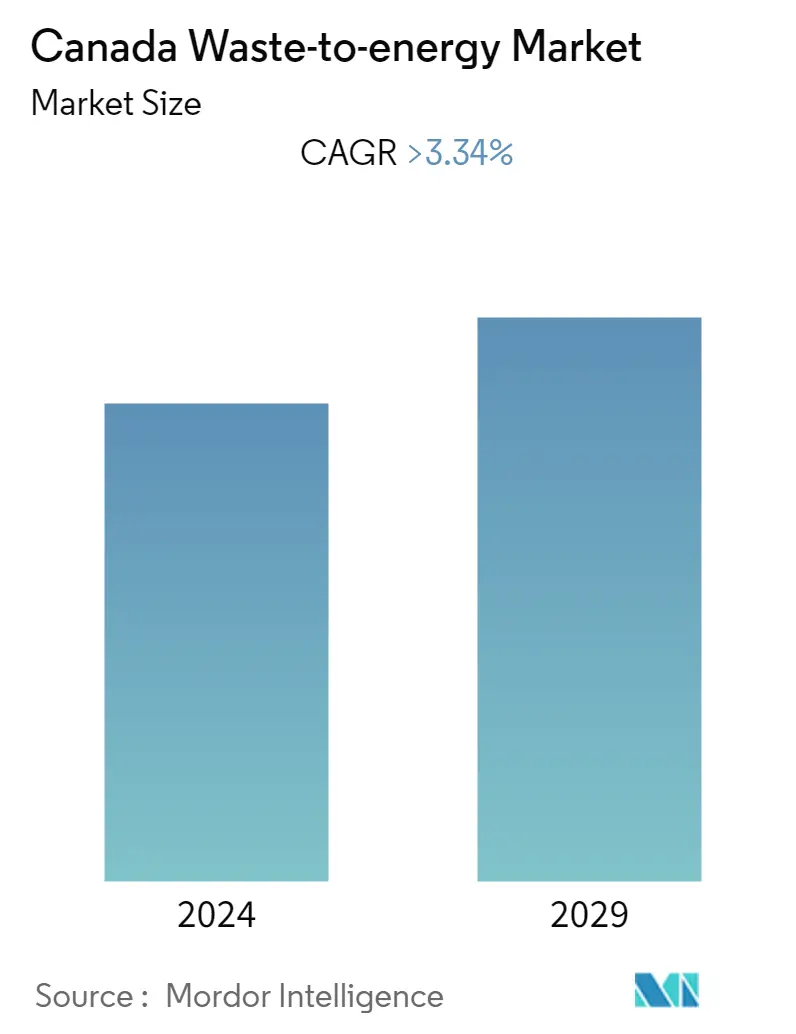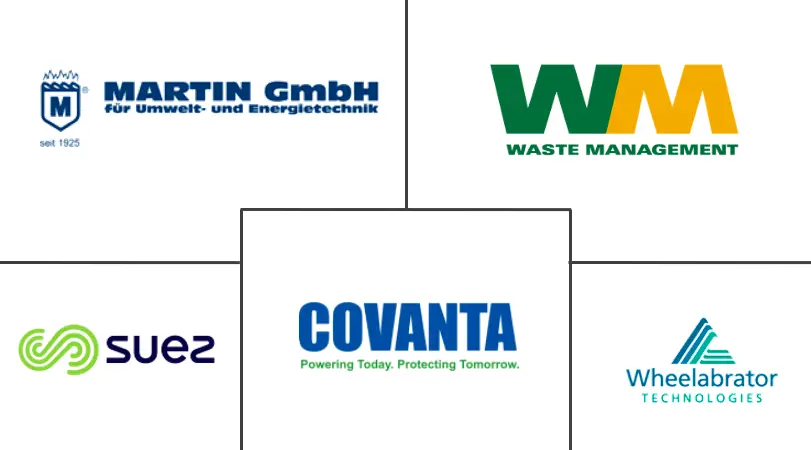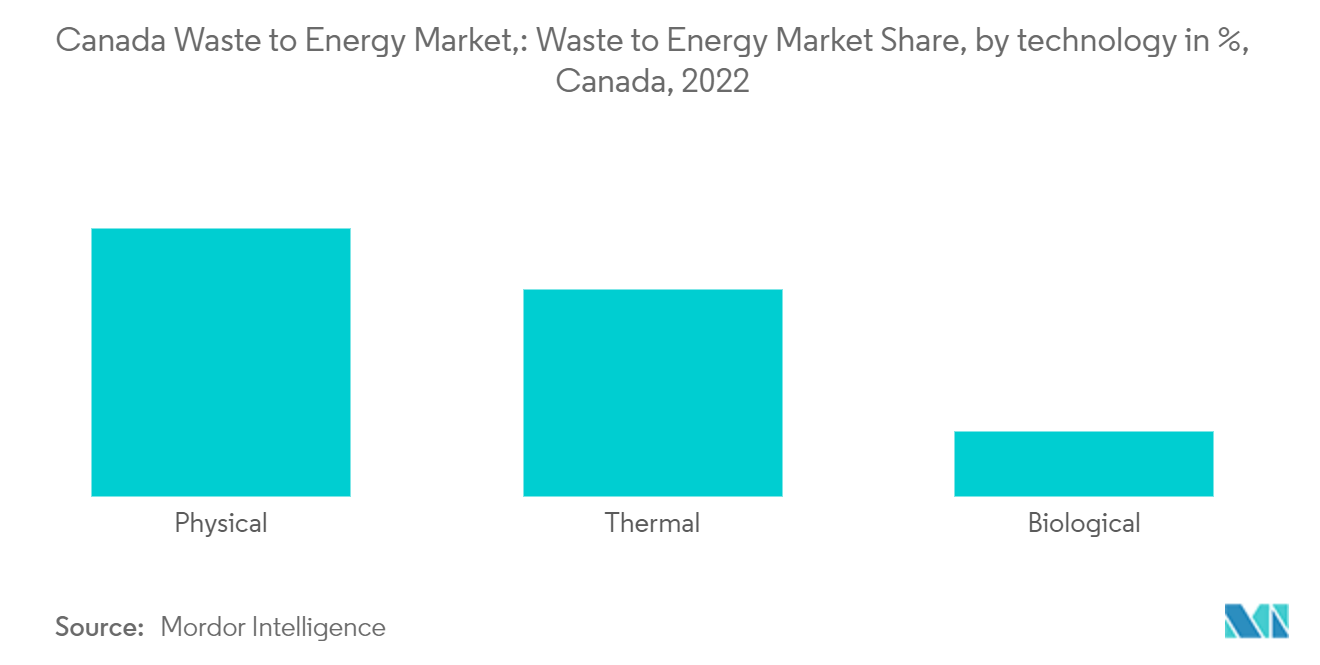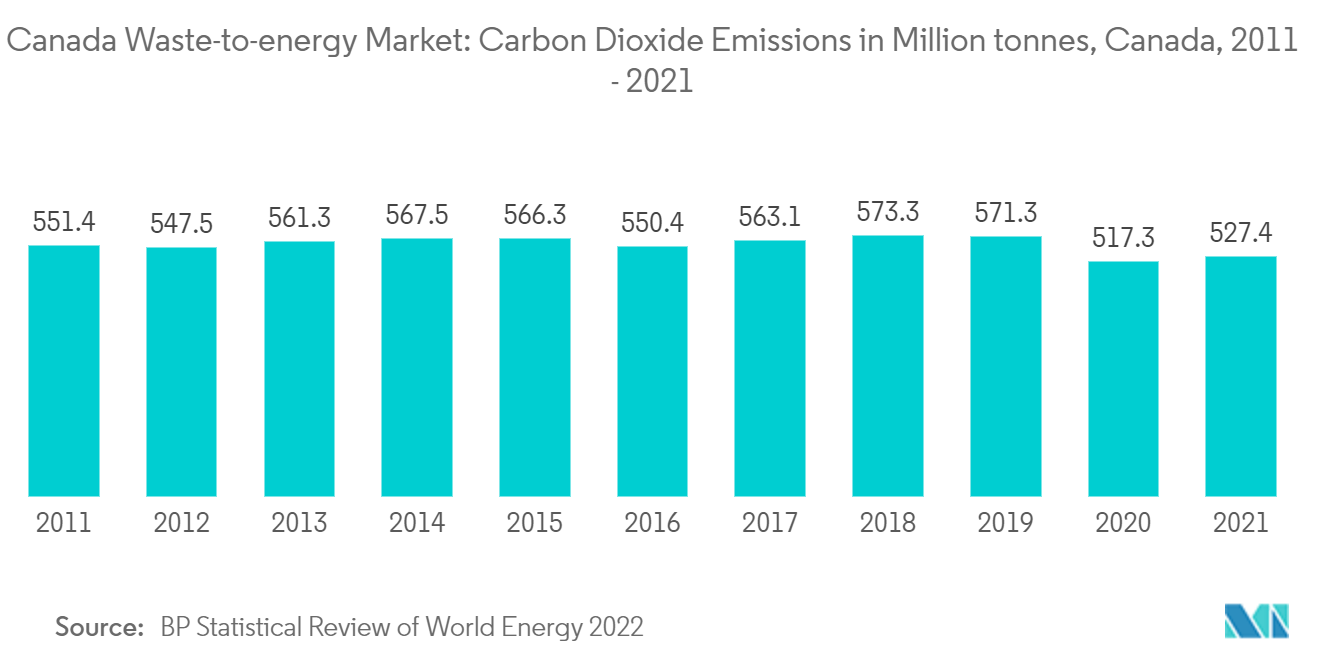Canada Waste to Energy Market Size

| Study Period | 2019 - 2029 |
| Base Year For Estimation | 2023 |
| Forecast Data Period | 2024 - 2029 |
| Historical Data Period | 2019 - 2022 |
| CAGR | > 3.34 % |
| Market Concentration | Medium |
Major Players
*Disclaimer: Major Players sorted in no particular order |
Need a report that reflects how COVID-19 has impacted this market and its growth?
Canada Waste to Energy Market Analysis
Canada's waste-to-energy market is expected to register a CAGR of more than 3.34% during the forecast period.
The outbreak of COVID-19 had a negative effect on the market. Currently, the market has rebounded to pre-pandemic levels.
- Canada has been one of the countries worldwide at the forefront of adopting WTE technologies, mainly because of the introduction of many favorable government initiatives.
- The country still lacks suitable policies and regulations concerning WTE, high capital investment, an increasing rate of recycling waste, and several other factors that have been restraining the growth of the WTE market.
- Technological advancements in the waste-to-energy sector are expected to create significant opportunities for plant operators in the near future. Municipalities in the state have moved toward both public and private companies to meet budget constraints and increase efficiency in managing WTE technologies.
Canada Waste to Energy Market Trends
Thermal-based Waste to Energy Conversion May Have Increasing Adoption
The thermal process involves treating waste to produce heat, which is then utilized to manufacture fuel oil or syngas from both organic and inorganic wastes or to generate electricity. Additionally, the thermal process could entail plasma arc gasification, pyrolysis, thermal gasification, or combustion.
- The most well-known WtE technology for processing municipal solid waste (MSW) at the moment is incineration. Combustible synthetic gas (syngas) is created by the gasification and pyrolysis processes, which can then be further upgraded and refined for direct generation in a gas turbine or engine. Due to lower operating temperatures, lower steam pressure, and a higher overall energy requirement for plant operation, incineration often has a better electrical efficiency rate than gasification. It is estimated that plants that utilize cogeneration of thermal power (heating and cooling) together with electricity generation can reach optimum efficiencies of 80%.
- WTE technologies, particularly incineration, produce pollution and carry potential health and safety risks. The following air emissions are associated with incineration facilities: metals, organics, acid gases, particulates, nitrogen oxides, and carbon monoxide. These incinerators have been highly scrutinized by NGO activists, public health agencies, and the general public, which influenced the legislators to impose stricter limits on emissions.
- To reduce particulate and gas-phase emissions, incineration plant owners have adopted a series of process units to clean the flue gas stream, which has, in turn, led to a significant improvement in terms of environmental sustainability.
- Gasification of waste produces fewer emissions per unit of generated power compared to both incineration and landfilling. If focused on the number of pollutant emissions per unit of treated waste, gasification is the preferred option, while incineration is considered the most harmful.
- Thus, the wide availability of technology, combined with a change in technology, is expected to lead to the increasing adoption of thermal-based WTE technology during the forecast period.

The Recycling Rate of Waste in Canada Remains a Restraint
- In Canada, around 107.2 million tons of municipal solid waste (MSW) are produced annually. About 47 million tons of the MSW produced were recycled, and 16 million tons were composted.
- A total of 63 million tons of MSW were recycled and composted, or 35.8% of the waste was recycled and composted.
- The numerous limits on excessive carbon emissions imposed by the new government laws restrict the development of the incineration process.In recent years, the nation has seen an increase in its carbon emissions.
- The market for incineration is also anticipated to be impacted by the intention to boost recycling of municipal solid waste to 60% by 2035.
- Overall, the increasing technological advancements in the recycling sector, combined with favorable government policies, are expected to slow down the growth of Canada's waste-to-energy market during the forecast period.

Canada Waste to Energy Industry Overview
Canada's waste-to-energy market is moderately fragmented. Some of the key players (in no particular order) are Martin GmbH, Suez SA, Covanta Holding Corp., Waste Management Inc., and Wheelabrator Technologies Inc., among others.
Canada Waste to Energy Market Leaders
Covanta Holding Corp
Martin GmbH
Suez SA
Waste Management, Inc
Wheelabrator Technologies Inc
*Disclaimer: Major Players sorted in no particular order

Canada Waste to Energy Market News
- March 2022: ANDION Global Inc. announced that the company secured a USD 20 million multi-partner financing to expand Andion's operations and acquire equity stakes in existing projects and accelerate the development of Andion's projects located across the world, including Canada.
- February 2022: A waste-to-energy plant came online in Meadow Lake, Saskatchewan, Canada. The plant is expected to provide power to around 5,000 homes in Saskatchewan and provide heat and power for a new continuous kiln.
Canada Waste to Energy Market Report - Table of Contents
1. INTRODUCTION
1.1 Scope of the Study
1.2 Market Definition
1.3 Study Assumptions
2. RESEARCH METHODOLOGY
3. EXECUTIVE SUMMARY
4. MARKET OVERVIEW
4.1 Introduction
4.2 Market Size and Demand Forecast in USD billion, till 2028
4.3 Recent Trends and Developments
4.4 Government Policies and Regulations
4.5 Market Dynamics
4.5.1 Drivers
4.5.2 Restraints
4.6 Supply Chain Analysis
4.7 PESTLE Analysis
5. MARKET SEGMENTATION BY TECHNOLOGY
5.1 Physical Technology
5.2 Thermal Technology
5.3 Biological Technology
6. COMPETITIVE LANDSCAPE
6.1 Mergers and Acquisitions, Joint Ventures, Collaborations, and Agreements
6.2 Strategies Adopted by Leading Players
6.3 Company Profiles
6.3.1 Martin GmbH
6.3.2 Suez SA
6.3.3 Covanta Holding Corp.
6.3.4 Waste Management Inc.
6.3.5 Wheelabrator Technologies Inc.
6.3.6 Ze-gen Inc.
6.3.7 Green Conversion Systems LLC
6.3.8 Mitsubishi Heavy Industries Ltd.
- *List Not Exhaustive
7. MARKET OPPORTUNITIES AND FUTURE TRENDS
Canada Waste to Energy Industry Segmentation
Waste-to-energy is the process of generating energy in the form of electricity and/or heat through the primary treatment of waste or the processing of the same into a fuel source. The technology used for this process includes physical, thermal, and biological technologies. The Canadian waste-to-energy market is segmented by technology into physical technology, thermal technology, and biological technology. For each segment, market sizing and forecasts have been done based on revenue (USD billion).
Canada Waste to Energy Market Research FAQs
What is the current Canada Waste-to-energy Market size?
The Canada Waste-to-energy Market is projected to register a CAGR of greater than 3.34% during the forecast period (2024-2029)
Who are the key players in Canada Waste-to-energy Market?
Covanta Holding Corp, Martin GmbH, Suez SA, Waste Management, Inc and Wheelabrator Technologies Inc are the major companies operating in the Canada Waste-to-energy Market.
What years does this Canada Waste-to-energy Market cover?
The report covers the Canada Waste-to-energy Market historical market size for years: 2019, 2020, 2021, 2022 and 2023. The report also forecasts the Canada Waste-to-energy Market size for years: 2024, 2025, 2026, 2027, 2028 and 2029.
Canada Waste to Energy Industry Report
Statistics for the 2024 Canada Waste to Energy market share, size and revenue growth rate, created by Mordor Intelligence™ Industry Reports. Canada Waste to Energy analysis includes a market forecast outlook to 2029 and historical overview. Get a sample of this industry analysis as a free report PDF download.
